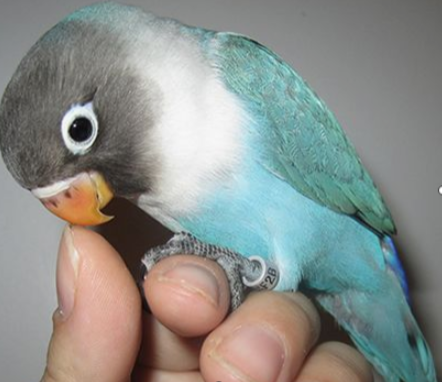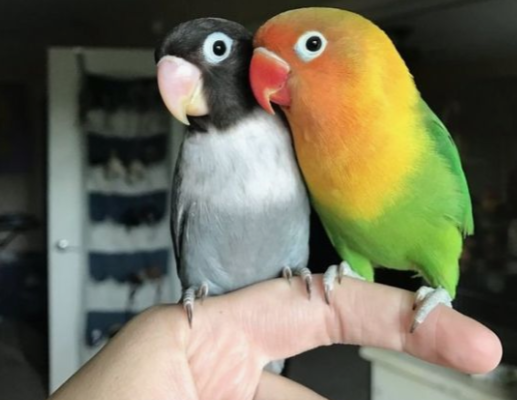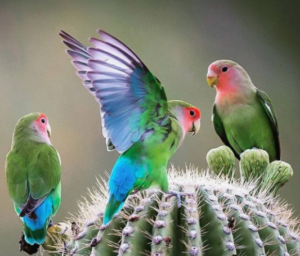
Lovebirds Are a Great Pet
Owning a parakeet is expensive and time-consuming, depending on the species. However, it is also an investment in your well-being, and it typically results in a good, rewarding partnership between you and your bird.
A smaller species is much less threatening when you fear diving into the world of birds as I did. Cockatiels, green-cheek conures, lovebirds, and parakeets make the introduction into the hobby a nice, less demanding one. These are also good options for living in apartments since they are less bruised and have less space than larger birds. Lovebirds are my dream.
Hand-Fed or Parent-Raised?
Lovebirds can be shockingly intriguing. These smaller males are just as intimate as the larger ones. The lovebirds, who are fed and raised by their parents, are always looking for adventure. You are daring, adventurous, and willing to consider your future.
Hand-Fed
Individuals who have been hand-fed tend to trust others and easily form attachments to new owners. Cultivators are simpler to find than you may imagine, and a well-adjusted baby is frequently available at a local bird show or pet store.
Parent-Raised
Lovebirds are available from parent-given outlets, chain pet stores, and a few small stores. Such birds can still make attractive animals, but new owners must be patient. You must demonstrate that individuals deserve confidence—a task for anyone who has never owned a bird before. Such birds are difficult to remove from their coats; nevertheless, if they do, the prize is equivalent.
How to Choose Your Bird
The decision between the two is based on local accessibility and the amount of time you wish to spend with someone. Lovebirds make terrific companion animals, whether they are hand-fed or raised by their parents. Lovebirds crave social connection and quickly form attachments to dependable owners.

Lovebirds enjoy conversing. They can communicate with their owners, although they lack the vocal abilities of Amazon parrots and African greys. In addition to her noisy chirping, my lovebird, Bonnie, could bark, whistle, and grub.
Pet Communication
Bonnie barks and whistles when she wants to be a pet or snuggled, indicating that she is interested in what I am doing. When I get too close to her nest during a hormone cycle, she grumbles, and her features puff. She begs to be released by running her beak up and down the cage bars, and when the dog gets too close, she cries a warning. Her capacity to convey her desires inspires me every day.
Lovebirds are quite busy. We want to always be at the center of the activity. Even the family’s birds seem to enjoy walking on their owner’s shoulders. Although they are cautious, it is just too appealing to avoid and can aid in the development of trust.

Lovebirds make excellent pets for people who are short in stature. The bird will require less food and toys, and these items will not need to be stored in large bins. Although the lovebirds require a large cage in comparison to their length, they are only seeking for a piece of furniture with a footprint of about 18×18 inches.
Initial Expenses
It’s not too pricey for this small parrot. Many breeders will market a well-adjusted lovebird for $30, which is what I asked for at a bird show for Bonnie. The pet businesses charge between $60 and $150 depending on the type and color.
Lovebirds want their bigger cousins to consider everything. You’ll buy quality food, an extra mineral, some toys, cage litter, bars, and other supplies. A high-quality birdcage is a vital aspect of lovebird security.
Every lovebird I owned had the typical slide-up doors on their low-end cages opened. Ensure that your bird does not leave the house unsupervised. When I was in the shop, I lost a number of books to clever lovebirds looking for anything to cut. A quality cage would cost between $100 and $250, but your bird (and things) would be safe.
Nutrition
Birds with high energy levels are called lovebirds. Nonetheless, they are considered candied eaters, and they require a sufficient diet to keep them active and healthy. If you are not exposed to a range of foods while you are weaning, you can stick to what you know: seeds. It is difficult for parents to consume nutritious, pellet-based foods. This makes things harder.
An ideal lovebird diet consists of a staple pellet containing a different seed each day, as well as fruits and vegetables. Pellets are more expensive than grains, but their nutritious content is significantly lower. A bag of food for cockatiels, conures, and other tiny hookbills will cost between $11 and $18. The small bags last a few months.
Cage, Grooming For Lovebirds

It’s a choice for cage litter. It makes it easier to wash a regular plate, but this is not a must. Simple pop-corn (popped) and vermiculite can be included in low-cost chips and beds like newspapers, old magazines, and phone books (you have to use one at last).
I buy a huge bag of vermiculite from a plant nursery for $11 because I’m too lazy to make popcorn every week and it’ll last a year. If your bird has direct access to the cage floor, popcorn is a safer and cleaner alternative. You do not want the vermiculite in her meal!
Lovebirds, in particular, provide valuable insights into the parrot cosmos. The scale, price, and personality make it a significant compromise for us, especially because there is no room or support for larger species. You can make enjoyable pals and a valued member of your life.

Leave a Reply